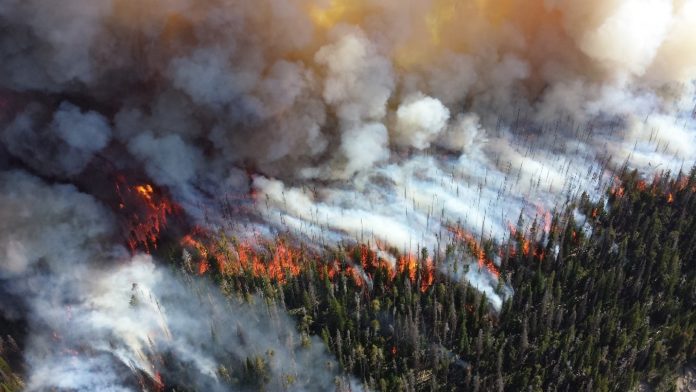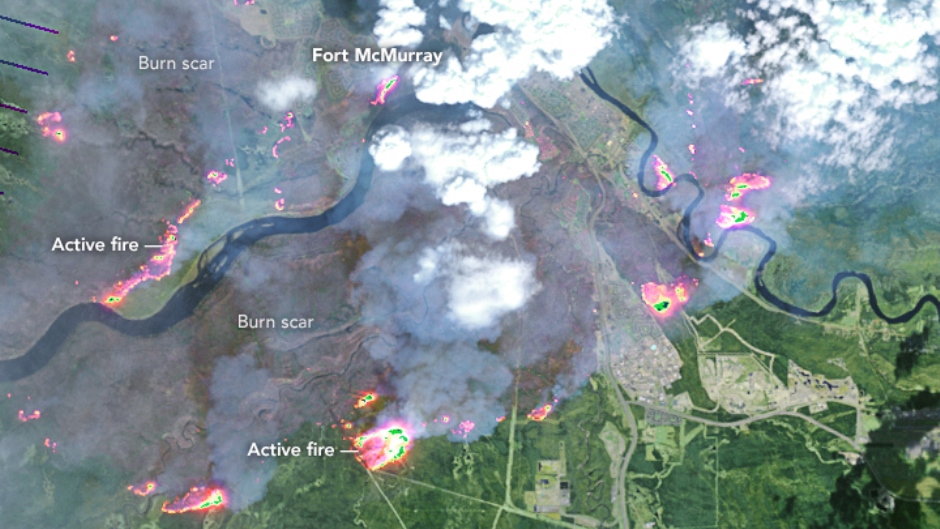The fire surrounding Fort McMurray has already burned through over 400,000 acres and displaced 80,000 people, but what you may not realize is that there are over 80 fires burning all over Canada right now. Wildfires are a natural part of the ecosystem, but how do they start and how do we prevent the ones that cause damage?
The wildfire that burned through Fort McMurray in Alberta. Credit: NASA Earth Observatory image by Joshua Stevens, using Landsat data from the U.S. Geological Survey.
Ignition
When conditions are right, all that’s necessary for a fire to start is a source of ignition, a spark. In about half the cases this source of ignition is lightning and, in the other half, it is human activity.
“There is an alarmingly consistent relationship between wildfire ignitions and roads, trails, and railway tracks,” says David Andison, Adjunct Professor in the Department of Forest Resources Management at UBC. In his own work, Prof. Andison tries to understand the patterns that wildfires create in the landscape over days, years, and even centuries. He also studies the relationship between climate and the size, shape, frequency, and intensity of wildfires.
The ignition source of the Fort McMurray fire is still under investigation.
Fires that rejuvenate
If a wildfire poses no immediate danger to anyone, it will often be allowed to burn. Wildfires are a natural part of the ecosystem and many plants have adapted to thrive after a fire.
“Fire is an incredibly important evolutionary force,” says Lori Daniels, Associate Professor in the Department of Forest and Conservation Sciences at UBC. Prof. Daniels research includes using tree rings to pinpoint the year and season when the fires burned going back to the 1300s, and interpreting how these fires affected the forest.
Low-intensity fires can actually stimulate the growth of certain grasses and shrubs. For example, lodgepole pine and jackpine cones are covered in a waxy substance that traps the seeds. These so-called “serotinous” cones require a trigger, like a fire, to release the seeds and replenish the trees. The ash from the fire then provides nutrients for the seedlings.
“Fire in those contexts rejuvenates the forest,” says Prof. Daniels.
If a fire burns too big or too hot, however, it is no longer beneficial to the environment. Very intense heat can cause soil damage and large burned areas can take a long time to replenish with seeds.
Fire fighting
Because humans are a major cause of wildfires, prevention is key. In Canada, the FireSmart program aims to educate communities about wildfires. In particular, it teaches how to assess fire hazards like dead trees, debris on the ground, or high tree density in the Wildland-Urban interface, where the forest meets human structures. These should be minimized to create a barrier against travelling flames.
“Ideally, we aim for a 2 km buffer zone around forested communities,” explains Prof. Daniels.
If a fire does occur close to a community, a decision may be made to control that fire. This might include ground crews, aerial water drops, bulldozers to create fire breaks, or controlled “back burns” to reduce the amount of fuel available for the main fire.
Unfortunately, once a fire, like the one in Fort McMurray, gets too big or too hot, the only thing that can stop it is one or more significant rain events.
“We are at Mother Nature’s mercy,” says Prof. Andison.
Increasing severity
Although the early spring timing, large size, and high severity of the Fort McMurray fire is rare, it may become increasingly common.
The weather in Western Canada is trending towards earlier springs, higher temperatures, and longer and more pronounced droughts. All of these conditions are consistent with climate change predictions made 20 years ago and all are perfect conditions for extreme fire hazard.
“In future, those exceptional conditions become the averages,” says Prof. Daniels. “It’s a little bit alarming.”
“How will the Ft Mac fire compare to those in the near future? I think the answer is that it will become more common every year,” adds Prof. Andison.
If you would like to help the people affected by the Fort McMurray fire, check out this page.









































